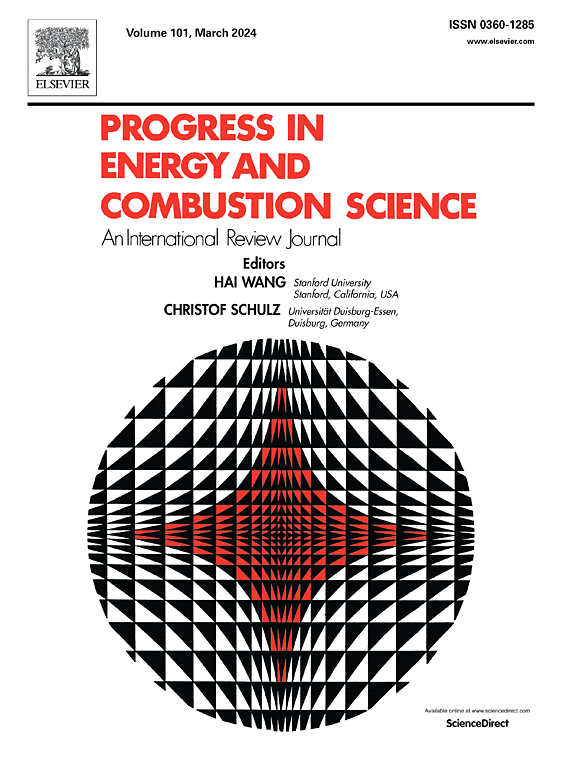Review of organic pollutants in coal combustion processes and control technologies
IF 37
1区 工程技术
Q1 ENERGY & FUELS
引用次数: 0
Abstract
Organic pollutants are acknowledged as one of the primary environmental hazards in the atmosphere, posing a significant threat to human health and the environment. This work provides a critical review of the recent research on organic pollutants from stationary coal-burning sources, including an overview of the effect of coal composition and coal source, the types of organics material in coal, the generation of organic pollutants during coal combustion, emission of organic pollutants, co-removal by air pollution control devices (APCDs), and the technologies used to remove organic pollutants from coal-fired power plants (CFPPs). Field sampling and analysis showed that the organic pollutants produced from coal combustion processes are mainly composed of volatile organic compounds (VOCs), polycyclic aromatic hydrocarbons (PAHs), and organic components in condensable particulate matter (CPM). The VOCs and CPM are mainly discharged into the atmosphere as part of the gas and particulate phases, respectively, whereas, PAHs are mainly concentrated in fly ash and bottom ash. The generation of organic pollutants during coal combustion is mainly affected by coal grade, temperature, heating rate, residence time, and pressure. Considering that the flue gas temperature and composition can vary from one CFPP location to another, the choice of the sampling methods is based on the specific needs of a CFPP. Because, the selection of a sampling method can significantly affect the final results and should be given special attention. Typical sampling methods for VOCs, PAHs, and CPM are summarized and their advantages and disadvantages are compared. The adsorption tube sampling method is more suitable for the sampling of VOCs because it is not limited by the volume and miscellaneous components of the flue gas. EPA Method 0010 and the dry impactor condensation method (EPA Method 202) are more suitable for sampling PAHs and CPM in flue gas due to their higher accuracy. The APCDs in CFPPs have organic pollutants co-removal abilities besides those for conventional pollutants. As a result, they can remove VOCs, PAHs, and CPM at efficiencies of 55.8–87.6 %, 74.7–89.8 %, and 36.3–81.5 %, respectively, with corresponding emission concentrations of 0.058–16.29 mg/m3, 0.42–43.3 μg/m3, and 5.9–65.1 mg/m3. Based on current publicly reported data, the VOCs, PAHs and CPM contents emitted by global coal-fired power plants are estimated to be 88.1 Gg, 6.76 Gg (2.22 Gg in flue gas and 4.54 Gg in fly ash), and 600 Gg (organic components: 328 Gg, inorganic components: 272 Gg), respectively. Among the many removal technologies reviewed: include improved selective catalytic reduction (SCR) catalysts; and an advanced oxidation process (AOP) combined with an SCR or with a wet flue gas desulphurization (WFGD) unit respectively are two potentially useful technologies for future use in CFPPs. The information collected and presented in this review will help in the formulation of air pollution control policies and the development and application of efficient removal technologies.
煤燃烧过程中有机污染物及其控制技术综述
有机污染物是大气中主要的环境公害之一,对人类健康和环境构成重大威胁。本文对固定燃煤源有机污染物的最新研究进行了综述,包括煤成分和煤源的影响、煤中有机物质的类型、煤燃烧过程中有机污染物的产生、有机污染物的排放、空气污染控制装置(apcd)的协同去除以及用于去除燃煤电厂(CFPPs)有机污染物的技术。现场采样分析表明,煤炭燃烧过程中产生的有机污染物主要由挥发性有机物(VOCs)、多环芳烃(PAHs)和可冷凝颗粒物(CPM)中的有机组分组成。VOCs和CPM主要以气相和颗粒相的形式排放到大气中,PAHs主要集中在飞灰和底灰中。煤燃烧过程中有机污染物的产生主要受煤的品位、温度、升温速率、停留时间和压力的影响。考虑到不同CFPP地点的烟气温度和成分可能不同,采样方法的选择应基于CFPP的具体需要。因为,抽样方法的选择会显著影响最终结果,应给予特别注意。总结了VOCs、PAHs和CPM的典型采样方法,并比较了它们的优缺点。吸附管采样法不受烟气体积和杂组分的限制,更适合VOCs的采样。EPA方法0010和干法冲击器冷凝法(EPA方法202)由于精度较高,更适合对烟气中的多环芳烃和CPM进行采样。CFPPs中的apcd除对常规污染物具有协同去除能力外,还具有有机污染物的协同去除能力。对VOCs、PAHs和CPM的去除率分别为55.8 ~ 87.6%、74.7 ~ 89.8%和36.3 ~ 81.5%,对应的排放浓度分别为0.058 ~ 16.29 mg/m3、0.42 ~ 43.3 mg/m3和5.9 ~ 65.1 mg/m3。根据目前公开报告的数据,全球燃煤电厂排放的挥发性有机化合物、多环芳烃和CPM含量估计分别为88.1 Gg、6.76 Gg(烟气中为2.22 Gg,飞灰中为4.54 Gg)和600 Gg(有机成分:328 Gg,无机成分:272 Gg)。综述了许多去除技术,包括改进的选择性催化还原(SCR)催化剂;高级氧化工艺(AOP)分别与SCR或湿法烟气脱硫(WFGD)装置相结合,是未来在CFPPs中使用的两种潜在有用技术。本检讨所收集和提供的资料,将有助制订空气污染管制政策,以及发展和应用有效的清除技术。
本文章由计算机程序翻译,如有差异,请以英文原文为准。
求助全文
约1分钟内获得全文
求助全文
来源期刊

Progress in Energy and Combustion Science
工程技术-工程:化工
CiteScore
59.30
自引率
0.70%
发文量
44
审稿时长
3 months
期刊介绍:
Progress in Energy and Combustion Science (PECS) publishes review articles covering all aspects of energy and combustion science. These articles offer a comprehensive, in-depth overview, evaluation, and discussion of specific topics. Given the importance of climate change and energy conservation, efficient combustion of fossil fuels and the development of sustainable energy systems are emphasized. Environmental protection requires limiting pollutants, including greenhouse gases, emitted from combustion and other energy-intensive systems. Additionally, combustion plays a vital role in process technology and materials science.
PECS features articles authored by internationally recognized experts in combustion, flames, fuel science and technology, and sustainable energy solutions. Each volume includes specially commissioned review articles providing orderly and concise surveys and scientific discussions on various aspects of combustion and energy. While not overly lengthy, these articles allow authors to thoroughly and comprehensively explore their subjects. They serve as valuable resources for researchers seeking knowledge beyond their own fields and for students and engineers in government and industrial research seeking comprehensive reviews and practical solutions.
 求助内容:
求助内容: 应助结果提醒方式:
应助结果提醒方式:


